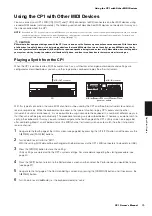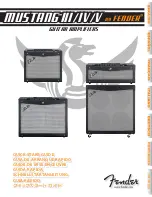
Storing Settings
CP1 Owner’s Manual
39
Qui
ck Star
t Guide
Storing Settings
Memory Structure
The following diagram shows the structure of the CP1’s internal memory and how data is exchanged with external
devices.
Flash ROM
As its name suggests, Read Only Memory (ROM) is a type of memory designed specifically for reading of data, and as
such, data cannot normally be written to it. Flash ROM differs from the conventional type in that it can be overwritten —
allowing you to store your own original data. Furthermore, the content of flash ROM is maintained even when the power is
turned off.
DRAM
The term Random Access Memory (RAM) is used to describe memory designed for both reading and writing of data.
RAM is categorized into two different types based on the way in which content is stored — namely, static RAM (SRAM)
and dynamic RAM (DRAM). It is the latter type that is used for your CP1’s Edit Buffer. As the data stored in DRAM is lost
when the power is turned off, any important content should be transferred to flash ROM (i.e., the User Performance
memory) before doing so.
Edit Buffer & User Memory
The name Edit Buffer is given to an area of memory used to edit a single Performance or system settings. As this memory
area is non-permanent, its content must be stored in User Memory if it is to be reused. Furthermore, whenever a new
Performance is selected and edited, the entire content of the Edit Buffer will be overwritten with the new data. It is
important, therefore, that any Performance in the Edit Buffer is stored as soon as you are happy with it.
*1
Internal Memory
Preset Data (ROM)
Preset Performance
Demo Songs
Edit Buffer
(DRAM)
Performances
Piano Type
Pre-Amplifier
Modulation Effect
Power-Amplifier /
Compressor
Reverb
Common Settings
System settings
Utility settings
Master Equalizer settings
User Memory
(flash ROM or DRAM)
*2
Performances
*3
Piano Type
Pre-Amplifier
Modulation Effect
Power-Amplifier /
Compressor
Reverb
Common Settings
System settings
Utility settings
Master Equalizer settings
MIDI instrument or
computer
Sequence application
USB Flash-Memory
Device
External Performance
memory
“EXTBANK.C1E”
File extension: .C1A
Internal communication
Communication between CP1 and
external device
Bulk Dump
Load
Store
Load
Store
F
ile lo
ad
ing
and
sa
vin
g
*1: The Bulk Dump function can be used only with data currently being edited in the Edit Buffer.
*2: User Performance memory banks reside in the instrument’s flash ROM, while External
Performance memories are loaded into the internal DRAM.
*3: Both User Performance memories and External Performance memories are displayed here in
the form of a single block.
















































